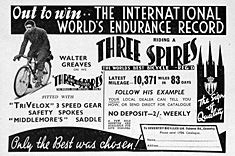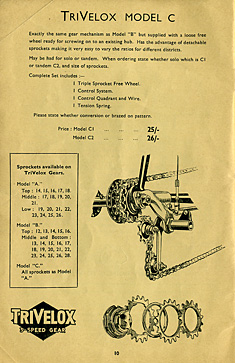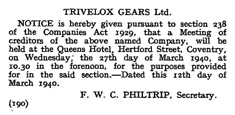Coventry Bicycles
The origins of Coventry Bicycles Limited are somewhat obscure. A 1912 directory of Warwickshire lists a Coventry Bicycle [sic] Company in Conduit Yard, Fleet Street. However the company Coventry Bicycles appears to have been established in Gosford Street in 1918 when two gentlemen named Barbury and Downes were appointed managers by Siegfried Bettmann of Triumph! Both men were former employees of Hobart, Bird & Company Limited, a manufacturer of bicycles and, later, motorcycles, that moved to Coventry from Wolverhampton in the late 1890s. By the mid-1920s Barbury and Downes were producing a motorcycle named the Coventry B[arbury] & D[ownes] from new premises in Wellington Street: and in 1927 the company was advertising its Three Spires brand of bicycle from the same address.

Frederick Thomas Downes (1877-1947), sometime managing director of Coventry Bicycles, Ltd. Photograph courtesy of John Gardner of Santa Fe, New Mexico, a grandson of his sister.
In about 1928 the company moved again, this time to a small industrial estate in Osborne Road in the Earlsdon district of the city. The estate was first developed in around 1902 when the Rex Motor Manufacturing Company Limited and the Acme Motor Company Limited both established factories there. A 1907 photograph of Osborne Road shows the Rex Factory in the middle distance on the left.
In 1922 Rex and Acme had merged to form the Rex-Acme Motor Manufacturing Company. The merger must have created a vacancy on the estate because it is believed a satellite of the Standard Motor Company then moved in and remained there until the arrival of Coventry Bicycles in 1928. Given that Siegfried Bettmann had bought a significant shareholding in the Standard Motor Company in 1912 and was on its board, it seems likely that he played a role in the transfer of Coventry Bicycles to the Osborne Road site.
By the early 1930s Coventry Bicycles was making an impressive range of machines in its Osborne Road factory. It was producing not only its core, Three Spires models, but also a number of less expensive EUREKA models. The latter were clearly aimed at a more price conscious segment of the bicycle market.
Following the purchase by Coventry Bicycles of the Triumph bicycle division in 1936, an acquisition in which Siegfried Bettmann also played a role, the company created a subsidiary company named TriVelox Gears Limited to produce the TriVelox gear. It was not long before a sequence of advertisements for the gear began to appear in the cycling press. Simultaneously the parent company promoted the gear through its advertising of the Three Spires range of bicycles.
(Despite having only one arm, Walter Greaves did set a new world record of more than 45,000 miles: the current record is more than 75,000!)
In 1937 or 1938 Coventry Bicycles vacated its Osborne Road premises and moved production of its Triumph and Three Spires bicycles into the old Triumph factory in Priory Street; production of the TriVelox gear had remained in Priory Street since the 1936 takeover of Triumph [1]. In about the same year TriVelox Gears Limited published a very impressive catalogue from the Priory Street address which ran to more than 30 pages. (The full catalogue can be viewed here.) As well as the classic in-line derailleur, promoted in the catalogue as the A model, the catalogue illustrated the newer B and C models [2]. Both the B and C models were off-line or moving chain derailleurs. The B model anticipated the free hubs of modern, moving chain derailleurs in that the free-wheel was built into the hub. The C model, on the other hand, had a loose free-wheel that could be screwed on to the existing rear wheel hub of a customer's bicycle. For both models the two inner sprockets were then slid on to the free-wheel and the third, outer sprocket was then screwed on to act as a lock ring. (A review of these new models can be viewed here, while a guide to repairing all three models (A, B, and C) can be viewed here.)
Despite these additions to its product line, a notice in the London Gazette in March 1940 showed that TriVelox Gears Limited was in serious financial difficulties. It is possible that production of the gear may have continued at the Priory Street factory, but worse was to come. Later in the year the factory was virtually destroyed by German bombs and this cataclysmic event brought to an end the manufacture of the TriVelox gear in Coventry.
William Hill, the inventor of the in-line TriVelox gear, spoke in 1984 to his nephew Melvyn Hirst about the bombing of the Priory Street factory. Bill had moved in the early 1930s from Tanfield Garage in Keighley to Coventry, to work first for Triumph and then for Coventry Bicycles, much to the annoyance of his former employer, Alec Shuttleworth. Bill also spoke about the role of Siegfried Bettmann in the manufacture of the TriVelox gear and the changes brought about when the Triumph bicycle business was sold to Coventry Bicycles. (Listen to a recording of their conversation here.)
At some point between 1936 and 1940 - conflicting dates are given in secondary sources - Coventry Bicycles, with its Three Spires and Triumph brands, had changed its name to Associated Cycle Manufacturers of Coventry: this was probably an umbrella name for the two parts of the business [3]. Then, in 1947, two seemingly contradictory events were reported in the press. The first was an announcement in a February issue of the London Gazette that Coventry Bicycles Limited was going into voluntary liquidation.
The second, five months later in July 1947, was a report in the Western Morning News that a new factory was being built for Associated Cycle Manufacturers of Coventry. This factory was built in Torrington Avenue, Coventry, and that is the address given in some, but not all, of the late-1940s advertisements for the company. In the example shown here, from 1949, the Torrington Avenue address is not given.
It may be relevant to the contradiction noted above that all Three Spires cycles are advertised as reserved for export, '[with] not a single machine . . . reaching the home market.' The Three Spires bicycle shown in the advertisement is a very basic one with only a single gear. Hence it is possible that Associated Cycle Manufacturers decided to liquidate most, if not all, of the manufacturing assets of Coventry Bicycles and target the mass, overseas market with just one, very simple-to-manufacture, Three Spires model. Only Triumph bicycles were being sold into the home market.
At the end of the Second World War Associated Cycle Manufacturers of Coventry was one of only two makers of bicycles remaining in the city. Eventually the company was taken over by Raleigh Industries in 1954 and production of its bicycles moved to Nottingham. The other company that remained after the war, the Coventry-Eagle Cycle and Motor Company Limited, moved to Smethwick in 1959, and this brought to an end the manufacture of bicycles in Coventry. How times had changed. In 1897, for example, there were seventy five companies in the city manufacturing complete bicycles [4].
In the meantime the TriVelox gear had arisen from the ashes! An item in The Bicycle in August 1940 reported that TriVelox Gears Limited had a new owner. This was just five months after the financial difficulties reported in the London Gazette in March.
The new owner was, of course, Alec Shuttleworth, formerly of Tanfield Garage, now of Tanfield Buildings in Keighley, one of the two original patentees of the gear along with William Hill. Both Shuttleworth and Hill had signed an agreement with the liquidator of TriVelox Gears Limited, dated 22 July 1940, which enabled the sale to proceed.
Alec Shuttleworth was intending to form a new company named the TriVelox Gear Company. He may have arranged for production to continue at Priory Street in Coventry until a new manufacturing facility was established in the North. But what he could not have known at the time was that the Priory Street factory would be in ruins by the end of the year.
Precisely what happened next, and when, is not entirely clear. But shortly after the end of the war the TriVelox gear was being manufactured in Spennymoor, County Durham, by a company named the TriVelox Gear Company (the name chosen by Alec Shuttleworth), a subsidiary of Smart & Brown (Engineers) Limited.
Notes
1. A 1939 catalogue for Triumph bicycles, which can be viewed in full on the Veteran-Cycle Club Library website by entering 'Triumph', without the quotes, into the search box, reveals that the word 'Cycle' had been re-introduced into the bicycle company name following the break-up of the parent Triumph Company in 1936. Selected pages from the catalogue can be viewed here, courtesy of the Veteran-Cycle Club.
2. The A model came in four variations. The A1 and A2 were for solo machines: the A2 incorporated a hub brake in combination with a large-flange hub. The A3 and A4 were for tandems, the A4 having a large hub brake and a large-flange hub. The A3 was a 'special gear' that lacked the hub brake: it could be supplied with either standard or large-flange hubs. The B model came in two variations, both for solo machines: the B1 did not incorporate a hub brake, the B2 did. The C model also came in two variations, both without the hub brake: the C1 was for solo machines, the C2 for tandems. A summary of the models and their variations can be viewed here.
3. A 1950 directory of Coventry manufacturers gives 1939 as the year of the change in name. The products manufactured by the company are given in the directory as "Triumph" pedal cycles, and the trade marks as "Triumph", "Three Spires", and "Gloria". The Gloria brand was employed by Triumph in its early days for a cheaper line of bicycles: rather like Coventry Bicycles with its lower-priced Eureka range.
4. See: Anthony Edward Harrison. 'The Competitiveness of the British Cycle Industry, 1890-1914'. Economic History Review, 1969, page 302.












